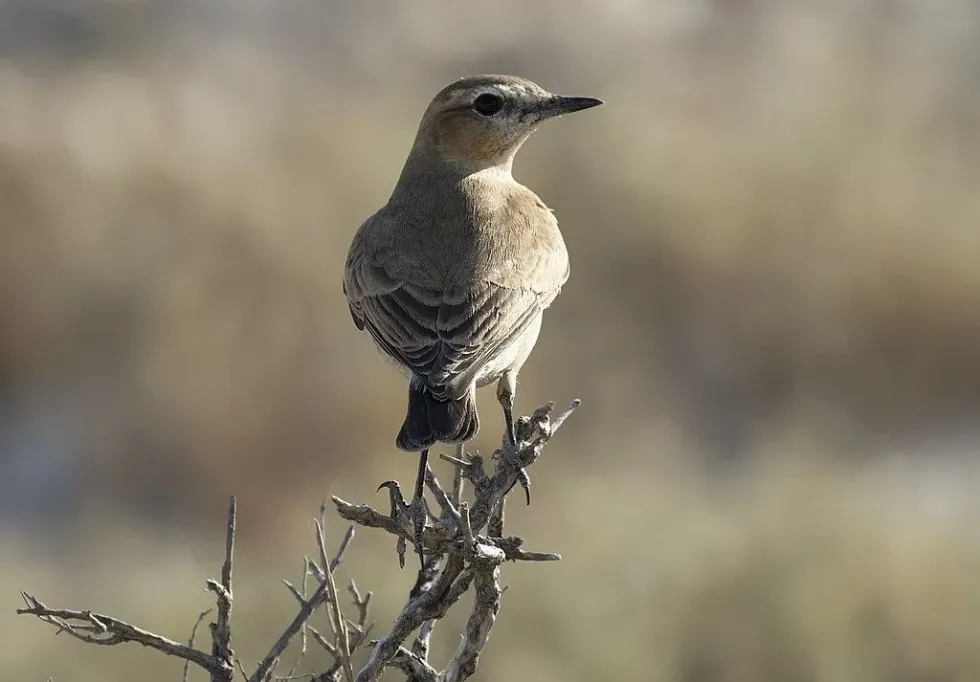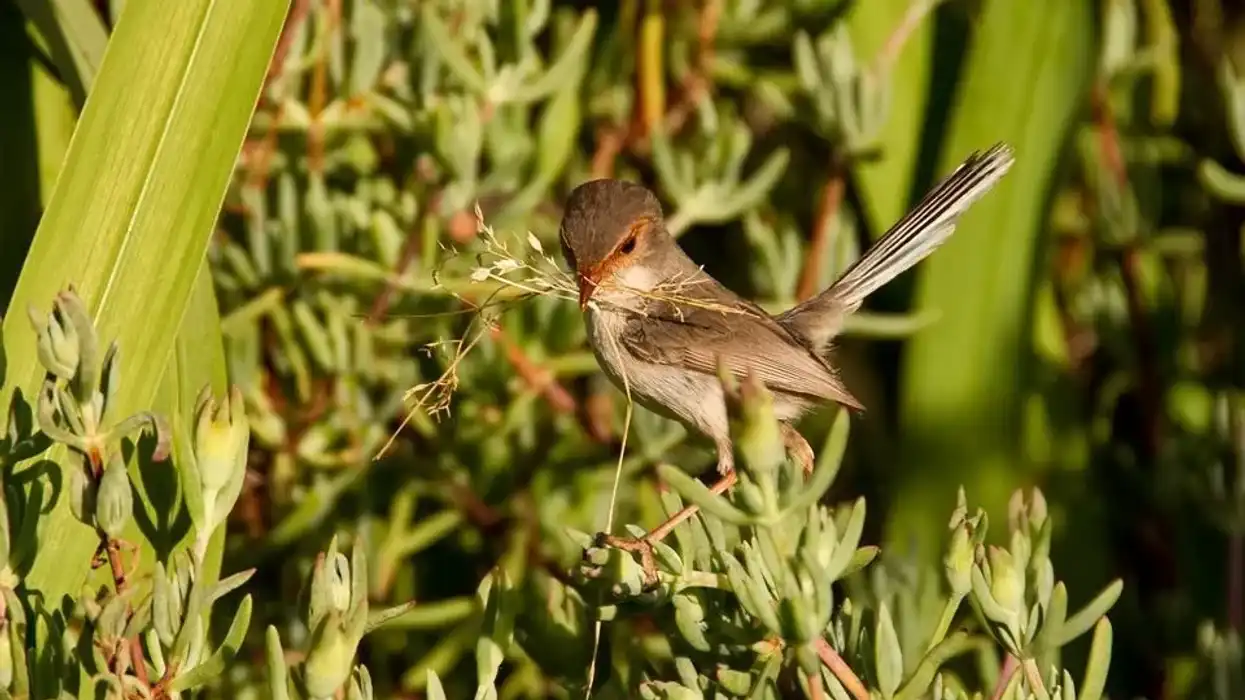The isabelline wheatear (Oenanthe isabellina) is a small songbird with a chirpy call note and beautiful wing feathers. It is pale brown in color with black tail feathers and white upper tail coverts and underwing coverts.
It is a migratory bird that moves to Central Asia and southeastern Europe for breeding and to Africa and northwestern India to spend the winters. Its identification may be difficult as it looks starkly similar to the Northern wheatear (Oenanthe oenanthe).
The differences between the two are that the Northern wheatear is a bit smaller in length than the isabelline wheatear and has grayish underwings rather than white ones. The isabelline wheatear has longer legs and stands more upright than the Northern wheatear.
They also have whiter ear-coverts than the Northern Wheatear. This bird lives alone and only associates with other birds while migrating.
If you want to know more about other birds, be sure to check out our common kingfisher facts and chipping sparrow facts pages.
Isabelline Wheatear Interesting Facts
What type of animal is an isabelline wheatear?
The isabelline wheatear is a type of bird, specifically, a songbird.
What class of animal does an isabelline wheatear belong to?
The isabelline wheatear belongs to the class Aves and the family Muscicapidae.
How many isabelline wheatears are there in the world?
The exact number of this species of birds in the world is unknown though it is estimated to be in the range of 27,500,000-83,000,000 individuals.
Where does an isabelline wheatear live?
The isabelline wheatears are migratory birds and are found in a number of countries. They move to Southern Russia, Iran, Iraq, Saudi Arabia, Jordan, and Southeast Europe in the breeding season, and in the winters, their distribution is mainly spread across Africa and northwestern India.
What is an isabelline wheatear's habitat?
The birds of this species are most commonly found in open countryside, dry plains, grasslands, semi-deserts, and deserts. They are known to prefer places where burrowing rodents are found as they use the abandoned burrows to later lay eggs.
Who do isabelline wheatears live with?
This species of birds live independently till the breeding season, after which each pair of male and female birds feed the chicks when they are born, but then drive the chicks away when they are old enough to live alone in the wild. They might also associate with other birds only while migrating to a different place.
How long does an isabelline wheatear live?
The lifespan of the isabelline wheatear (Oenanthe isabellina) is currently unknown.
How do they reproduce?
This species has a nest that is made up of dried grass, roots, and feathers and is situated underground inside a burrow. The range of the clutch size is two to seven eggs, which can be pale blue in color.
After the eggs hatch, both the male and female birds feed the chicks with insects. For about two weeks, the parents keep feeding the chicks but then drive them out of the territory.
What is their conservation status?
There is no known threat to this species and their distribution, which is why their population is stable enough to be classified as Least Concern by the IUCN.
Isabelline Wheatear Fun Facts
What do isabelline wheatears look like?
The isabelline wheatears have beautiful features and are pale sandy brown or parchment colored with slight orange tones. There is not much contrast in its plumage like other birds except on the fringes of its wing feathers, which are darker, grayish-brown in color.
Its upper tail coverts and rump is white whereas the ear coverts are pale brown, matching most of its plumage. Its underwing feathers are a shocking white compared to the rest of its plumage and the tail feathers, although short, are completely black.
The isabelline wheatear has much less contrast in its wing feathers and plumage than the Northern wheatear, which makes both of their identification somewhat easier for birdwatchers.
This species is seen as having an almost upright posture. Its dark legs are so long that even when upright, its tail feathers will hardly touch the ground.

How cute are they?
With a number of attractive features like a fuzzy feathered breast and belly, sleek pale brown coverts, and dark tail feathers, this species is one of the most adorable birds in the world. It also has a delightful call note and can mimic other sounds around it.
How do they communicate?
It is currently unknown how or whether an isabelline wheatear (Oenanthe isabellina) communicates with another of its kind other than when the male wheatear courts the female bird during which it goes up in the air performing stunts while singing.
The birds call of these birds includes loud whistle notes, chirping, and imitating the sounds around them in the environment.
Their call note sometimes sounds like rocks being struck together with shorter whistles.
How big is an isabelline wheatear?
This species is roughly 5.9–6.5 in (15–16.5 cm) in length, which makes them larger than a Northern wheatear (Oenanthe oenanthe) and about five times smaller than a Muscovy duck.
How fast can an isabelline wheatear fly?
The exact speed with which the isabelline wheatears fly is currently unknown. The bird has, however, been seen flying by quite fast with its white underwing coverts on display.
How much does an isabelline wheatear weigh?
An average isabelline wheatear (Oenanthe isabellina) is very light and weighs around 1-1.3 oz (29-38 g). They are about the same weight as a fox sparrow.
What are the male and female names of the species?
There are no specific names for the male and female birds of this species.
What would you call a baby isabelline wheatear?
A baby isabelline wheatear is called a chick, like most other birds, when they hatch out of their eggs.
What do they eat?
These birds mostly feed on a number of insects like ants, grasshoppers, beetles, moths, and flies. They usually stay and look for insects on the ground itself but might occasionally fly up to catch a particular one.
The isabelline wheatears are attacked by pikas. These predators are also how the birds select the site of their nest as they tend to make their nest in a place where the pika distribution is sparse or non-existent.
Are they dangerous?
This species is not known to be particularly dangerous or harmful to human beings as it is a very small bird.
Would they make a good pet?
These wheatears are not usually taken in as pets and are quite used to their migratory lifestyle in the wild. Hence, it would not be fair to confine these very active birds to a cage.
Did you know...
The isabelline wheatears go through a process called molting of feathers twice a year where they shed their old feathers while growing new ones. Once in the late summer, they shed all their feathers, and then in mid-winter, when they partially shed their feathers.
Different types of Wheatear
There are approximately 27 species of wheatears in the world. They are called wheatears because of their 'white rears', the white rump, one of the few features all of them share.
They can range from black to brown with yellow tinges. Most of them are found in open and dry regions across Eurasia and Africa. The most common of them all is the northern wheatear which can also be found in Alaska and northeastern Canada.
Do isabelline wheatears migrate?
Yes, isabelline wheatears are migratory birds. They move to parts of Southern Russia, Turkey, Iran, Iraq, and Jordan in the breeding season and spend the winters in Africa and northwestern India.
Here at Kidadl, we have carefully created lots of interesting family-friendly animal facts for everyone to discover! For more relatable content, check out these secretary bird facts and Amazon parrot facts for kids.
You can even occupy yourself at home by coloring in one of our free printable desert wheatear coloring pages.









